
Assessing Learning in the Standards-Based Classroom
A Practical Guide for Teachers
Whether you are well versed in writing proficiency scales or are seeking practical guidance on classroom assessment that best supports student learning, this book will help you design standards-based assessments that provide meaningful data to inform your next steps in the instructional cycle.
Successfully integrate assessment practices that inform effective instruction for every student
What do successful assessments look like? According to this team of authors, they provide meaningful assessment data that inform your instruction to help your students reach proficiency in priority standards. With the help of this practical guide, learn how to successfully integrate assessment with the standards-based teaching and learning process to improve student performance and evaluate instructional efficacy.
This book will help K–12 teachers and assessment coordinators:
- Gain clarity on the different roles of assessment throughout the instructional cycle
- Determine the timing and format of assessments to best support student learning
- Address test validity, reliability, and fairness
- Understand collaborative techniques for assessment consistency
- Access numerous sample assessments from the field
Related Topics
Additional Information
“The authors provide valuable insights into how teachers and collaborative teams can use assessment to improve learning and teaching. This book is packed with helpful ideas, clear examples, and actionable steps for improving the use of assessment in a standards-based learning environment. It’s an important resource that will help in shifting educators’ thoughts and philosophies about the role of assessment in today’s classrooms.”
“In this book, Jan Hoegh and colleagues provide classroom teachers with a step-by-step approach to designing high-quality classroom assessments that can be employed in traditional classrooms, standards-referenced classrooms, and competency-based classrooms. Using proficiency scales as their foundation, the authors clearly exemplify how teachers can render assessment, student feedback, and instructional design with a unified, seamless system.”
“Hoegh, Flygare, Heflebower, and Warrick provide a valuable resource for educators in developing an understanding of the principles of sound assessment in the classroom. Teachers, administrators, higher education faculty, and professional developers can all benefit from the research-based yet practical guidance supported by examples of how to implement these principles and practices. This is a book that I would strongly recommend to any educator wanting to strengthen their assessment literacy and support effective communication of assessment to students, parents, and the public.”
When can I access my eBook? Your eBook will be accessible through VitalSource once your payment has been processed.*
*When using a check or purchase order, the order submitted online will not be processed until Solution Tree receives the check or a copy of the signed official purchase order. Your purchase order must note payment terms of net 30 days. We cannot process purchase orders that do not note these payment terms. Please submit all payments to [email protected].
How do I access my eBook?
To access your eBook:
- Create a free VitalSource account by visiting VitalSource.com. If you already have a VitalSource account, please log in to your account.
- Paste the redemption code that Solution Tree will email you in the “Redemption Code” field on VitalSource.com/Redeem. (Note: You can also access your redemption code within your Solution Tree account under the “eBook” section.)
- Click “Redeem.”
- Enjoy! Once your code is redeemed, your book will be added to your VitalSource Bookshelf and can be read anytime, anywhere.
What are the technical requirements for accessing the eBook? A VitalSource account is required. To sign up for your free account, please visit VitalSource.com.
What if I have trouble accessing my eBook? Please contact VitalSource by emailing [email protected] or by utilizing their Live Chat feature.
What are the shipping and handling costs? There are no shipping or handling costs associated with eBooks. For paperback and hardcover book purchases, standard shipping costs apply. Please visit the Product Orders page for more information on shipping and handling costs.
Can I purchase multiple copies of the same eBook? Bulk orders are not currently available through the website. Website purchases are limited to one eBook per title, per account. If you want to order multiple copies of an eBook, please contact customer support at [email protected].
What if I need to request a refund on my eBook order? RETURN POLICY: We are unable to accept returns or cancel previously placed eBook orders.



